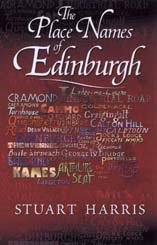
 | Place Names of Edinburgh Stuart Harris |
| sample extract... | |
EDINBURGH perhaps emerges from prehistory in the first half of the 2nd century, inasmuch as it may have been the British Alauna, rockplace, which Ptolemy lists among the 'towns' of the Votadini, a British tribe who inhabited southeast Scotland and northeast England in Roman times; but it is clearly identified in the late 6th century, when the heroic poems of the Gododdin (the Votadini name in its later Welsh form, to be pronounced roughly as gau-'dauth-een, with th as in 'the') named the place both as Eidyn and as Din Eidyn or 'Fort Eidyn', and also described it as Eidyn ysgor or Eidyn gaer, the stronghold or fortified town of Eidyn. All these forms use 'Eidyn' (pronounced 'aid-in) as a proper name, and the same is true of the later versions made for the invading groups of Anglians and Gaelic-speaking Scots, typified in the note 'Dunedene, which is in English Edineburg' given in the 9th-century Life of St Monenna: for while British din could be translated (no doubt, as usually happens in such circumstances, by conquered Britons for the benefit of new overlords) as equivalent to Anglian burh or Gaelic dun, it is evident that Eidyn had to be left untranslated. Not to be confused with Anglian eoten or Scots etin, a giant, or with Gaelic eadainn or aodainn, a slope, it seems to have been the name of the place, rather than a district, but is otherwise obscure. The fanciful form 'Edwinesburgh' is a palpable fake that appears in the time of David I and was probably an attempt to manufacture a link with Edwin, first Christian king of Northumbria; but there is no evidence that Edwin ever campaigned in Scotland, and fair evidence that Eidyn did not fall to the Northumbrians until some five years after he died in 633, and in any case there are the decisive objections that the native Gododdin called their capital Eidyn long before any Anglian set foot in Lothian, and that even if (with a stretch) the forms Eden or Edine might be derived from 'Edwin's', it is simply impossible that that could be the origin of British Eidyn or Gaelic Eidean. It is not known exactly when the settlement east of the Rock was made a royal burgh (a title which used the word no longer as 'fortress' but in its new sense of 'trading centre') but it was certainly before 1128, when the foundation charter of Holyrood abbey frequently mentions it as already existing, and it may have been before Alexander I rebuilt St Giles kirk in about 1120. The term burgh appears in both its old and new senses in the medieval title The royal burgh of Edinburgh: 'the royal trading centre of fortress Edin'. EDINA and EMBRO are late 18th-century forms, the first devised to personify the town, chiefly for poetical purposes, and the second a colloquial reduction of the name, showing the same tendency to change n into m as occurs in names like Dumbryden and (in normal parlance) Dunfermline. |
|